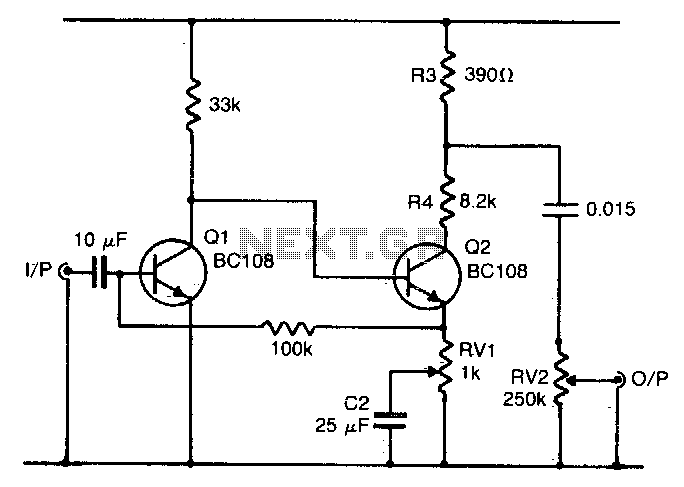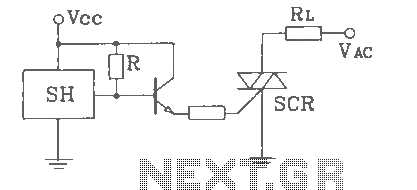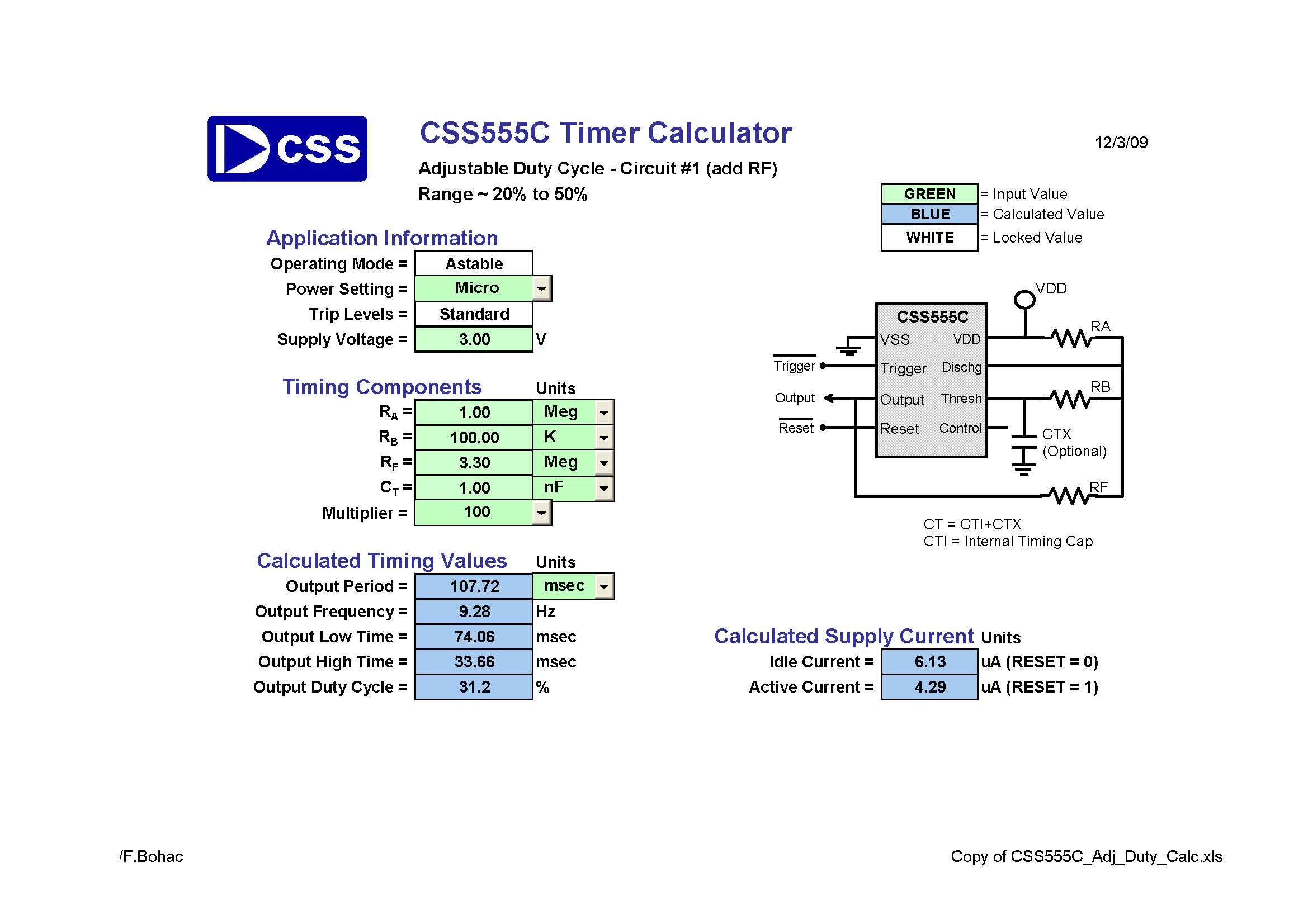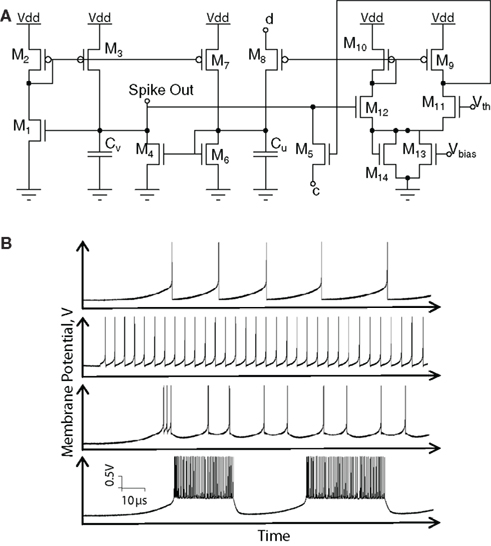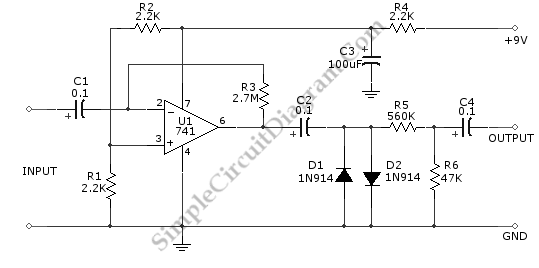
silicon fuzz
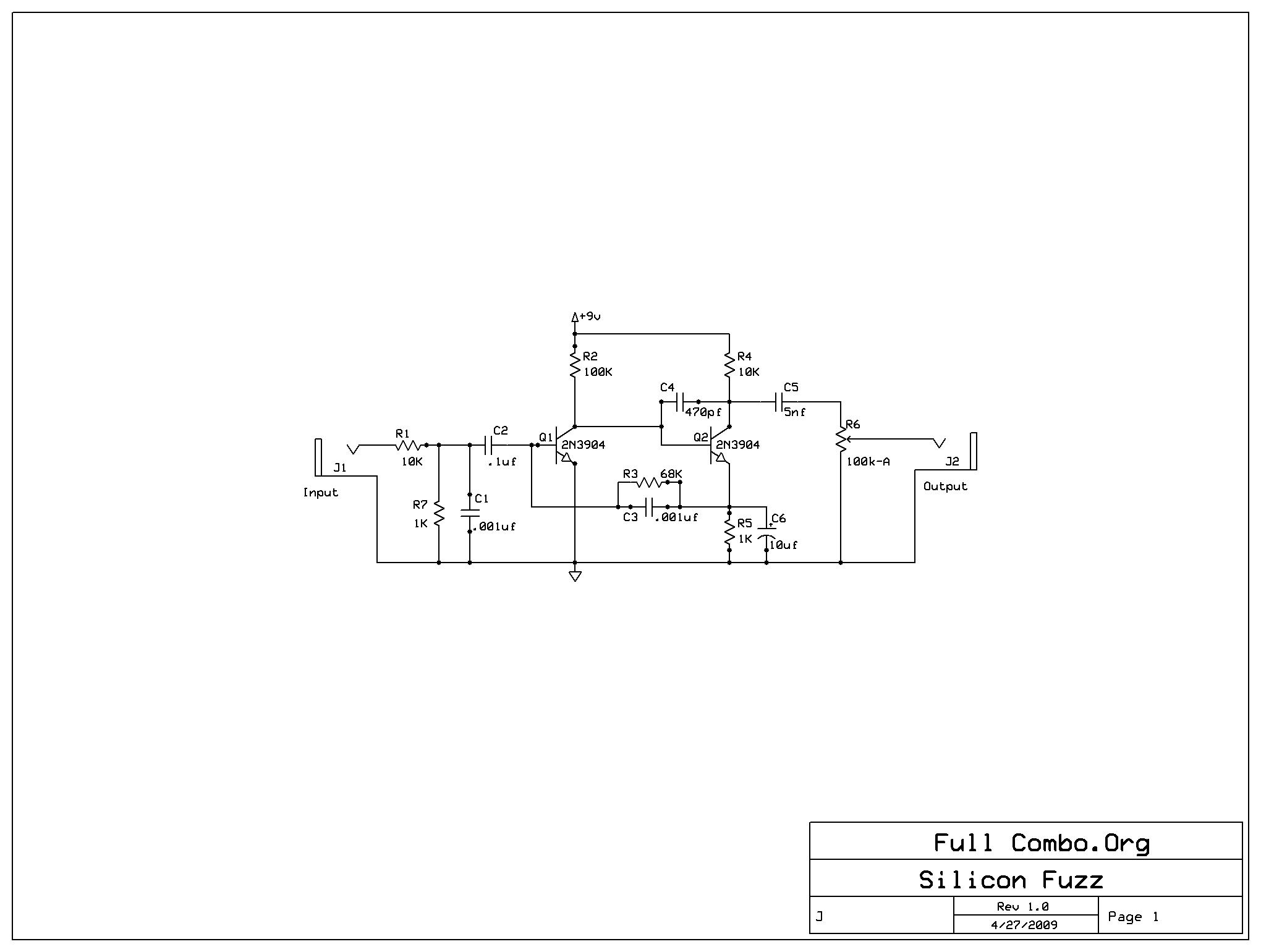
After constructing the Mighty Mite amplifier project, it became apparent that an additional element was needed to enhance its character. A Hendrix-style fuzz face was considered to add an edge to the tone while allowing for character during low-volume playing. The exploration of this device revealed a complexity that belied its apparent simplicity, consisting of just two NPN transistors along with a few capacitors and resistors. Extensive research into the circuit's functionality and the wealth of information available online regarding components, modifications, and sound qualities ensued. The objective was to create a well-performing fuzz box using only scrap materials and available parts, avoiding any store purchases. Much discussion surrounding the fuzz face centers on the transistors utilized. This device, being quite old, is often credited with initiating the distortion/fuzz trend in rock music, particularly with the Rolling Stones' track "(I Can't Get No) Satisfaction." As early as 1968, hobbyist projects in publications like Popular Electronics were encouraging DIY enthusiasts to build this straightforward device, which likely sparked ongoing debates. Initially, transistors were made from Germanium, a naturally occurring mineral with semiconductor properties that were enhanced through doping. Eventually, Silicon became the preferred material due to its cost-effectiveness, manufacturability, and thermal stability, although early audio circuits were optimized for the unique characteristics of Germanium. The two-transistor fuzz box design is noted for being both highly optimized and peculiar. Many contemporary DIY fuzz projects claim that authentic tone can only be achieved with low-gain, leaky collector-to-base junction Germanium transistors, which are often available at a premium price. When modern silicon transistors are used, they are typically accompanied by a disclaimer indicating that the sound quality is acceptable but inferior to that of Germanium-based designs. The circuit's purpose is to take the smooth sine-wave output of an electric guitar and overdrive it, transforming the signal into a distorted square wave with varying wavefront shapes. The resulting sound is often described as aggressive and capable of damaging speakers, raising concerns about transistor quality. It is acknowledged that today's silicon transistors are more efficient and offer significantly higher current gain than their Germanium predecessors. Consequently, modern silicon transistor fuzz circuits often require design adjustments to manage the high gain. The simplicity of building a fuzz box contributes to the multitude of designs and variations stemming from the original concept introduced by Dallas Arbiter over forty years ago. In pursuit of cost-effectiveness, transistors salvaged from a disassembled Zircon Stud Finder were utilized. Fortunately, this yielded two suitable 2N3904 transistors, along with several reusable capacitors. The current gain of the 2N3904 varies based on collector current and voltage, but in this application, it is expected to provide a current gain of approximately 150.
The Mighty Mite amplifier and the fuzz face circuit together create a unique audio experience, blending the clean amplification of the guitar signal with the rich, textured distortion of the fuzz face. The schematic for the fuzz face typically includes two stages of amplification, each utilizing an NPN transistor configuration. The first transistor amplifies the input signal, while the second transistor further boosts the signal before it is sent to the output. Capacitors are strategically placed to filter out unwanted frequencies, ensuring that only the desired harmonics are produced.
In this configuration, the input signal from the guitar is fed into the base of the first transistor, which is configured in a common emitter arrangement. This arrangement provides voltage gain and inverts the signal. The collector of the first transistor is connected to the base of the second transistor, allowing it to amplify the already boosted signal further. The output of the second transistor is then coupled through a capacitor to the output jack, where it can be sent to an amplifier or effects chain.
Additionally, resistors are employed to set the biasing conditions for each transistor, ensuring they operate within their optimal range. The choice of resistors and capacitors can significantly influence the tonal characteristics of the fuzz face, allowing for various modifications to achieve the desired sound.
In summary, the integration of the Mighty Mite amplifier with a fuzz face circuit constructed from salvaged components exemplifies the principles of DIY electronics and the enduring appeal of classic audio effects. The careful selection of transistors, along with strategic component placement, culminates in a versatile and powerful fuzz effect that pays homage to its roots in rock music history.After building the Mighty Mite amplifier project, I found that it needed something extra to give it character. I thought a nice Hendrix-style fuzz face would add a nice edge to the tone as well as allow some character to come along with low-volume playing.
Well, what a universe unfolded when I started researching the internal workings of this devi ce. It is perhaps the perfect example of seeming simplicity masking amazing nuance and system complexity. The damn thing is just two NPN transistors and a few caps and resistors! However, you can spend days 1) trying to figure out how the circuit works and 2) weeks/months combing through the mountain of information on the net about components, modifications, what sounds good, what sounds bad, etc.
I made it my goal to understand this enigma and build a good-sounding fuzz box out of 100% scrap and on-hand parts. No trip to the store, no expense. Nothing but some previously junk-parts and some wire and solder. Much of the wind that has been expelled about the fuzz face is about the transistors in use. Note that the fuzz face is a very old device. It is said that the Rolling Stones (I Can`t Get No) Satisfaction started the whole distortion/fuzz trend that quickly became the standard for Rock guitar.
As early as 1968, hobbyist projects and articles in Popular Electronics were guiding the DIY crowd in building this simple device. That`s probably where the controversy started. Back in that day, transistors were made from a magical substance called Germanium This naturally occurring mineral was discovered to have semi-conductor properties when the Germanium crystals were "doped" or otherwise mixed with slight impurities.
Soon Silicon replaced Germanium for several reasons including cost, manufacturability, and thermal stability. However, early electronics, especially audio circuits, were optimized around certain aspects (peculiarities, you might say) of Germanium.
The two-transistor Fuzz Box is probably both the most optimized AND peculiar of any design. Most current DiY fuzz projects insist that proper tone can only be had with the low-gain, leaky collector->base junction Germanium transistors. All of the parts stores seem to have a stash of these and dole them out at pretty high prices. When a design stoops to use a modern silicon transistor design, it is usually also accompanied by a disclaimer that this design sounds "Ok" but clearly not as good as a Ge based design.
Ok, well. let me get this straight. We`re designing a circuit that takes the nice modal sine-wave output of an electric guitar and overdrives this signal until it more resembles a square wave with some RC constant wavefront shapes thrown in for good measure. The output of this wave is described as shredded and about to tear your speakers apart. and we`re concerned about quality of the transistors Actually, I say the above somewhat in jest because there is a concern about the gain of these transistors and the operation of the circuit.
It is a fact that today`s Si transistors are much more efficient and produce much higher current gain that the Ge devices from before. That`s why when you see a silicon transistor fuzz circuit today, most of the design tweaks are about mitigating the high gain.
Couple this with the ease of building a fuzz box and you can begin to understand why there are so many different designs and tweaks for basically the same design that Dallas Arbiter unleashed upon the world more than forty years ago. In keeping with my frugality quest, I decided to use the transistors that were soldered into a scrapped Zircon Stud Finder that I had in my scrap box.
As luck would have it, there were two very nice 2N3904 devices as well as a bunch of salvageable caps just waiting to be de-soldered and re-used. The current gain of the 2N3904 varies with collector current and voltage but in this application it should provide a current gain of about 150.
That soun 🔗 External reference
The Mighty Mite amplifier and the fuzz face circuit together create a unique audio experience, blending the clean amplification of the guitar signal with the rich, textured distortion of the fuzz face. The schematic for the fuzz face typically includes two stages of amplification, each utilizing an NPN transistor configuration. The first transistor amplifies the input signal, while the second transistor further boosts the signal before it is sent to the output. Capacitors are strategically placed to filter out unwanted frequencies, ensuring that only the desired harmonics are produced.
In this configuration, the input signal from the guitar is fed into the base of the first transistor, which is configured in a common emitter arrangement. This arrangement provides voltage gain and inverts the signal. The collector of the first transistor is connected to the base of the second transistor, allowing it to amplify the already boosted signal further. The output of the second transistor is then coupled through a capacitor to the output jack, where it can be sent to an amplifier or effects chain.
Additionally, resistors are employed to set the biasing conditions for each transistor, ensuring they operate within their optimal range. The choice of resistors and capacitors can significantly influence the tonal characteristics of the fuzz face, allowing for various modifications to achieve the desired sound.
In summary, the integration of the Mighty Mite amplifier with a fuzz face circuit constructed from salvaged components exemplifies the principles of DIY electronics and the enduring appeal of classic audio effects. The careful selection of transistors, along with strategic component placement, culminates in a versatile and powerful fuzz effect that pays homage to its roots in rock music history.After building the Mighty Mite amplifier project, I found that it needed something extra to give it character. I thought a nice Hendrix-style fuzz face would add a nice edge to the tone as well as allow some character to come along with low-volume playing.
Well, what a universe unfolded when I started researching the internal workings of this devi ce. It is perhaps the perfect example of seeming simplicity masking amazing nuance and system complexity. The damn thing is just two NPN transistors and a few caps and resistors! However, you can spend days 1) trying to figure out how the circuit works and 2) weeks/months combing through the mountain of information on the net about components, modifications, what sounds good, what sounds bad, etc.
I made it my goal to understand this enigma and build a good-sounding fuzz box out of 100% scrap and on-hand parts. No trip to the store, no expense. Nothing but some previously junk-parts and some wire and solder. Much of the wind that has been expelled about the fuzz face is about the transistors in use. Note that the fuzz face is a very old device. It is said that the Rolling Stones (I Can`t Get No) Satisfaction started the whole distortion/fuzz trend that quickly became the standard for Rock guitar.
As early as 1968, hobbyist projects and articles in Popular Electronics were guiding the DIY crowd in building this simple device. That`s probably where the controversy started. Back in that day, transistors were made from a magical substance called Germanium This naturally occurring mineral was discovered to have semi-conductor properties when the Germanium crystals were "doped" or otherwise mixed with slight impurities.
Soon Silicon replaced Germanium for several reasons including cost, manufacturability, and thermal stability. However, early electronics, especially audio circuits, were optimized around certain aspects (peculiarities, you might say) of Germanium.
The two-transistor Fuzz Box is probably both the most optimized AND peculiar of any design. Most current DiY fuzz projects insist that proper tone can only be had with the low-gain, leaky collector->base junction Germanium transistors. All of the parts stores seem to have a stash of these and dole them out at pretty high prices. When a design stoops to use a modern silicon transistor design, it is usually also accompanied by a disclaimer that this design sounds "Ok" but clearly not as good as a Ge based design.
Ok, well. let me get this straight. We`re designing a circuit that takes the nice modal sine-wave output of an electric guitar and overdrives this signal until it more resembles a square wave with some RC constant wavefront shapes thrown in for good measure. The output of this wave is described as shredded and about to tear your speakers apart. and we`re concerned about quality of the transistors Actually, I say the above somewhat in jest because there is a concern about the gain of these transistors and the operation of the circuit.
It is a fact that today`s Si transistors are much more efficient and produce much higher current gain that the Ge devices from before. That`s why when you see a silicon transistor fuzz circuit today, most of the design tweaks are about mitigating the high gain.
Couple this with the ease of building a fuzz box and you can begin to understand why there are so many different designs and tweaks for basically the same design that Dallas Arbiter unleashed upon the world more than forty years ago. In keeping with my frugality quest, I decided to use the transistors that were soldered into a scrapped Zircon Stud Finder that I had in my scrap box.
As luck would have it, there were two very nice 2N3904 devices as well as a bunch of salvageable caps just waiting to be de-soldered and re-used. The current gain of the 2N3904 varies with collector current and voltage but in this application it should provide a current gain of about 150.
That soun 🔗 External reference
